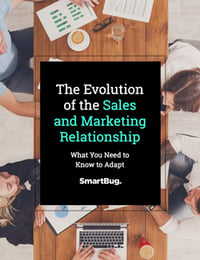
TOFU, MOFU and BOFU: The Sales Funnel Explained
December 11, 2019
Today's buyer is more informed than ever, and as sales and marketing professionals, it’s our responsibility to educate and provide relevant information at each step of the buyer’s journey.
Once your buyer enters the sales funnel—the buying process that will bring him or her from lead to customer—it’s critically important to qualify and nurture him or her along the way.
While the idea of a sales funnel isn’t new, the way we approach it has changed significantly over the years. While the details of the funnel can (and should) be different for every organization, this basic framework will lay the foundation for marketing and sales success within your organization.
Let’s break it down:
Top of the Funnel (TOFU)
At this stage in the funnel, you probably have a significant amount of leads. And, frankly, a majority of those leads aren’t going to buy from you. They know they have a potential problem, but they’re not quite sure how to solve it, so they’re doing their research.
Much like you wouldn’t ask someone to marry you on the first date, you don’t want to move too quickly with leads at the TOFU. What I mean by that is, if you come on too strong by trying to sell or inundate with too much information, the lead will become annoyed.
At this point, the lead is still trying to educate him or herself and might not even know what your company does (and that’s okay). Building trust with quality content in order to educate and inform will help keep him or her around for the long haul.
You’ll want to work to qualify (and disqualify) leads so that you can focus on those who will turn into customers.
In terms of content for these leads, you’ll want to offer pieces like:
- Blog posts
- Research reports
- E-books
- White papers

Middle of the Funnel (MOFU)
Once your leads reach the middle of the funnel, they know they have a problem, and it’s one that’s clearly defined. If you have a well-functioning sales funnel, you’ve disqualified a decent amount of leads in the move from TOFU to MOFU.
Leads at this stage in the sales funnel aren’t quite ready to evaluate vendors, but they are focused on researching all the ways they can solve their problem. You’re still working on building trust with these leads, so again, don’t go in for the sale or come on too strongly. Continue to nurture them until they’re ready to move to the next stage, which is BOFU.
In MOFU, you’ll want to offer pieces like:
- Comparison guides—be sure not to compare vendors at this point; instead, you’ll want to compare solutions
- Videos
- Podcasts
- Webinars
Bottom of the Funnel (BOFU)
Leads in BOFU are highly qualified and should be ready to purchase. They have done a significant amount of research, have defined their solution, and have probably identified several vendors that they’re comparing.
They know who you are, what you do, and what you provide, and it’s likely they have the same information about your competitors.
At this point, the lead should be ready to talk to you. This isn’t an excuse to come at him or her with a hard sell, because—let’s be honest—selling like that just doesn’t work anymore. A consultative approach of helping him or her come to his or her decision will ensure that you seal the deal.
BOFU content offer ideas include:
- Case studies
- Vendor comparisons
- Live demo
- Trial
- Consultation
TOFU, MOFU, and BOFU in Action
Let’s say you’re a marketer. Your leads have been declining over the last six months, but you’re not exactly sure why. Are they leads from your website? Sales-generated leads? You determine that you need to do some research. While your team is pulling some internal numbers, you start doing research online. Your online searches bring you to the blog post 25 Resources for Increasing Conversions. The post is helpful and gives you some great ideas to take back to your team. You also read the different sources linked within the post. Again, all helpful and all a part of your research, or the TOFU stage of the sales funnel.
Through your research online, and your team’s internal research, you have determined that the source of the problem is lead generation on your website—it’s just not driving leads like it used to. You’re now in the MOFU stage of the sales funnel, because you have clearly given a name to your problem, and you’re committed to understanding how to solve that problem. Upon further research, you find The Busy Marketer's Guide to Generating More Leads Online. It’s just what you were looking for at this stage of the sales funnel. You download the ebook and read it cover to cover. You now feel like you have a good handle on what needs to be done.
At this point, you’re entering the BOFU stage of the sales funnel, because you have defined your solution—you know you need to execute an inbound marketing strategy. While you don’t have all the internal resources in order to make this happen, you’re looking at several inbound marketing agencies that can act as an extension of your team. You’ve narrowed it down to three agencies, and you start doing your homework: You read their case studies and testimonials and schedule a marketing consultation with each. You’re just steps away from making a decision.
This approach is wildly different from the traditional way of selling, which included cold-calling, pressuring, and “limited-time offers” to close a deal. The bottom line? We can’t sell and market like we used to—today’s buyer won’t stand for it. Educate and inform at each and every stage of the sales funnel and truly trust the process. It’ll result in a better experience for all of us.
This post was originally published in August 2016 and has been updated since.
About the author
Ashley Lesperance was formerly a Marketing Strategist at SmartBug Media. She has a unique background in nonprofit work, education access, business development, sales and most recently, marketing. She's passionate about helping businesses achieve their growth goals through inbound marketing. Outside of work, Ashley enjoys spending time with her partner and their two cats, Batman and Elbert, as well as traveling whenever possible, tracking down the best cocktail in town, soaking up any moment of sunshine, and learning embroidery. Read more articles by Ashley Lesperance.








